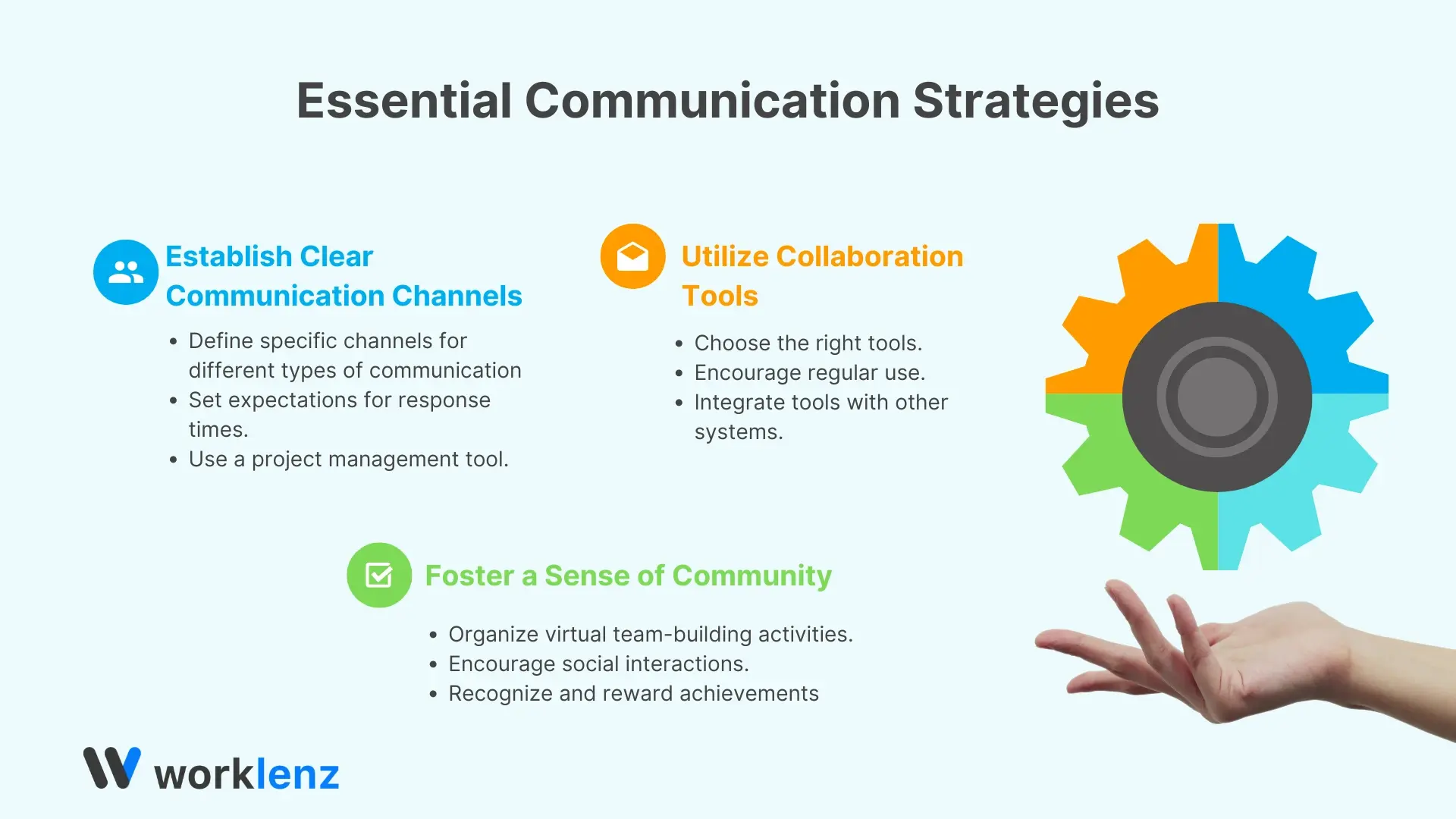
Remember when remote work was just a fringe concept? Well, those days are over. With 73% of workers saying they’d prefer to work remotely at least some time, according to a recent Upwork survey, remote work is now the norm, not the exception. It’s a brave new world, one that’s reshaping the way we work and collaborate.
But this shift hasn’t come without its challenges. One of the biggest hurdles is effective communication. When teams are scattered across the globe, it can be tough to maintain the same level of connection and understanding that you get in a traditional office setting.
In this article, we’ll explore key strategies that can help remote and hybrid teams overcome these challenges and build strong, productive relationships.
Remote and hybrid work offer flexibility and convenience, but they also introduce unique communication challenges. Here are some of the most common hurdles that teams face:
Time Zone Differences
Coordinating schedules and meetings across multiple time zones can be a logistical nightmare.
Inconsistent Communication
Ensuring everyone has access to the same information and is on the same page can be difficult when team members are scattered geographically.
Lack of Face-to-Face Interaction
Building rapport and fostering a sense of camaraderie can be more challenging in a virtual environment.
Technological Limitations
Poor internet connections, technical glitches, and software incompatibilities can hinder communication and productivity.
Overcoming these challenges requires a deliberate and strategic approach. By implementing the right strategies, remote and hybrid teams can build strong relationships, improve collaboration, and achieve their goals.
To navigate the challenges of remote and hybrid work, teams need to adopt effective communication strategies. Here are some essential tips:
Define specific channels for different types of communication. Use email for formal announcements, instant messaging for quick updates, and video calls for in-depth discussions.
Set expectations for response times.Clearly communicate when team members can expect replies to messages and when they should be available for meetings.
Use a project management tool. Tools like Worklenz can help teams stay organized, track progress, and ensure everyone is on the same page.
Choose the right tools. Consider factors like features, ease of use, and cost when selecting collaboration tools.
Encourage regular use. Make sure team members are familiar with the tools and are using them effectively.
Integrate tools with other systems. Connect your collaboration tools with other software, such as email and calendars, to streamline workflows.
Organize virtual team-building activities. Games, quizzes, and online happy hours can help build relationships and strengthen team morale.
Encourage social interactions. Create opportunities for informal chats and casual conversations.
Recognize and reward achievements. Celebrate successes and acknowledge contributions to boost morale and foster a positive team culture.

While effective communication strategies are essential, the right tools can also significantly enhance collaboration and productivity in remote and hybrid teams. In the following section, we’ll explore some of the most valuable communication tools and how they can be used to overcome the challenges of remote work.
The right tools can make a big difference in the effectiveness of remote and hybrid teams. Here are some of the most valuable communication tools to consider:
To maximize the benefits of video conferencing in your remote or hybrid team, it’s essential to choose a reliable platform that offers high-quality video and audio, as well as a range of useful features. Consider factors like screen sharing, recording capabilities, and integration with other tools to ensure a seamless experience. Encourage your team to use video conferencing regularly to maintain a sense of connection and foster collaboration, even when working remotely.
A well-chosen project management tool can significantly streamline workflows and improve communication within remote and hybrid teams. When selecting a tool, consider your team’s specific needs, such as task management, time tracking, and reporting capabilities. To maximize its benefits, encourage your team to use the tool consistently for all project-related tasks and integrate it with other communication and collaboration tools to create a seamless workflow.
To ensure effective communication and collaboration within your remote or hybrid team, it’s important to choose a messaging platform that is widely used and familiar to everyone. This will make it easier for team members to stay connected and participate in conversations. To keep discussions organized and focused, create dedicated channels for different teams, projects, or topics. Additionally, establish clear guidelines for response times to ensure that messages are addressed promptly and efficiently.
By leveraging these tools effectively, remote and hybrid teams can improve communication, increase productivity, and build stronger relationships.
Let’s face it, effective communication is the backbone of any successful team. But when you’re working remotely or in a hybrid setup, it can be even more challenging. That’s why it’s crucial to have a clear plan in place. In this section, we’ll walk you through the steps to establish solid communication strategies that will keep your team on track and working together seamlessly.
Create a document outlining communication expectations, channels, and best practices.
Involve team members in the process to ensure the guidelines are relevant and practical.
Regularly review and update the guidelines to keep them current.
Provide training on effective communication techniques, such as active listening, clear articulation, and non-verbal communication.
Encourage practice and feedback to help team members develop their skills.
Address communication challenges proactively to prevent issues from escalating.
Evaluate the effectiveness of your communication strategies to identify areas for improvement.
Gather feedback from team members to get their insights and perspectives.
Make necessary adjustments to your communication strategies based on the feedback and changing circumstances.
This format can help readers easily follow the steps involved in establishing clear communication strategies.
By following these steps, remote and hybrid teams can establish a strong foundation for effective communication and build a more cohesive and productive work environment.
The COVID-19 pandemic accelerated the adoption of remote and hybrid work, and this trend is likely to continue in the years to come. As technology advances and businesses adapt to changing workforce demands, we can expect to see significant developments in the future of remote and hybrid work.
1. Increased automation
Automation will likely play a larger role in remote and hybrid work, freeing up employees to focus on higher-value tasks.
2. Advancements in communication technology
Continued advancements in video conferencing, messaging apps, and collaboration tools will enhance communication and collaboration among remote teams.
3. Hybrid work models
Hybrid work models, which combine remote and in-office work, are likely to become more prevalent as businesses seek to balance flexibility with productivity.
4. Global workforce
As technology enables remote work, businesses may increasingly tap into global talent pools, creating more diverse and international teams.
The future of remote and hybrid work presents both challenges and opportunities. Businesses will need to address issues such as:
1. Managing employee burnout
The lines between work and personal life can blur in remote and hybrid settings, leading to burnout.
2. Ensuring equitable opportunities
Remote and hybrid work must be designed to avoid creating disparities based on location or access to technology.
3. Maintaining company culture
Building and maintaining a strong company culture can be more challenging in remote and hybrid environments.
Despite these challenges, the future of remote and hybrid work is bright. By embracing these trends and addressing the challenges proactively, businesses can reap the benefits of a more flexible, productive, and innovative workforce.
In conclusion, we’ll summarize the key points discussed in the article and offer some final thoughts on the importance of effective communication in today’s remote and hybrid work landscape.
Remote work has redefined communication—it’s no longer just about getting the message across; it’s the lifeblood of team cohesion, trust, and achievement. By leveraging the strategies outlined above, remote and hybrid teams can overcome the hurdles of distance, foster meaningful relationships, and reach their full potential.
The truth is, effective communication is more than words exchanged. It’s about understanding, connecting, and moving forward together with purpose. Strong communication builds strong teams—and strong teams deliver extraordinary results.
Take the first step to leveling up your team’s communication and productivity. Discover how Worklenz can bring your team closer, no matter how far apart they are. It’s time to lead the way in the digital workplace—click here to learn more!